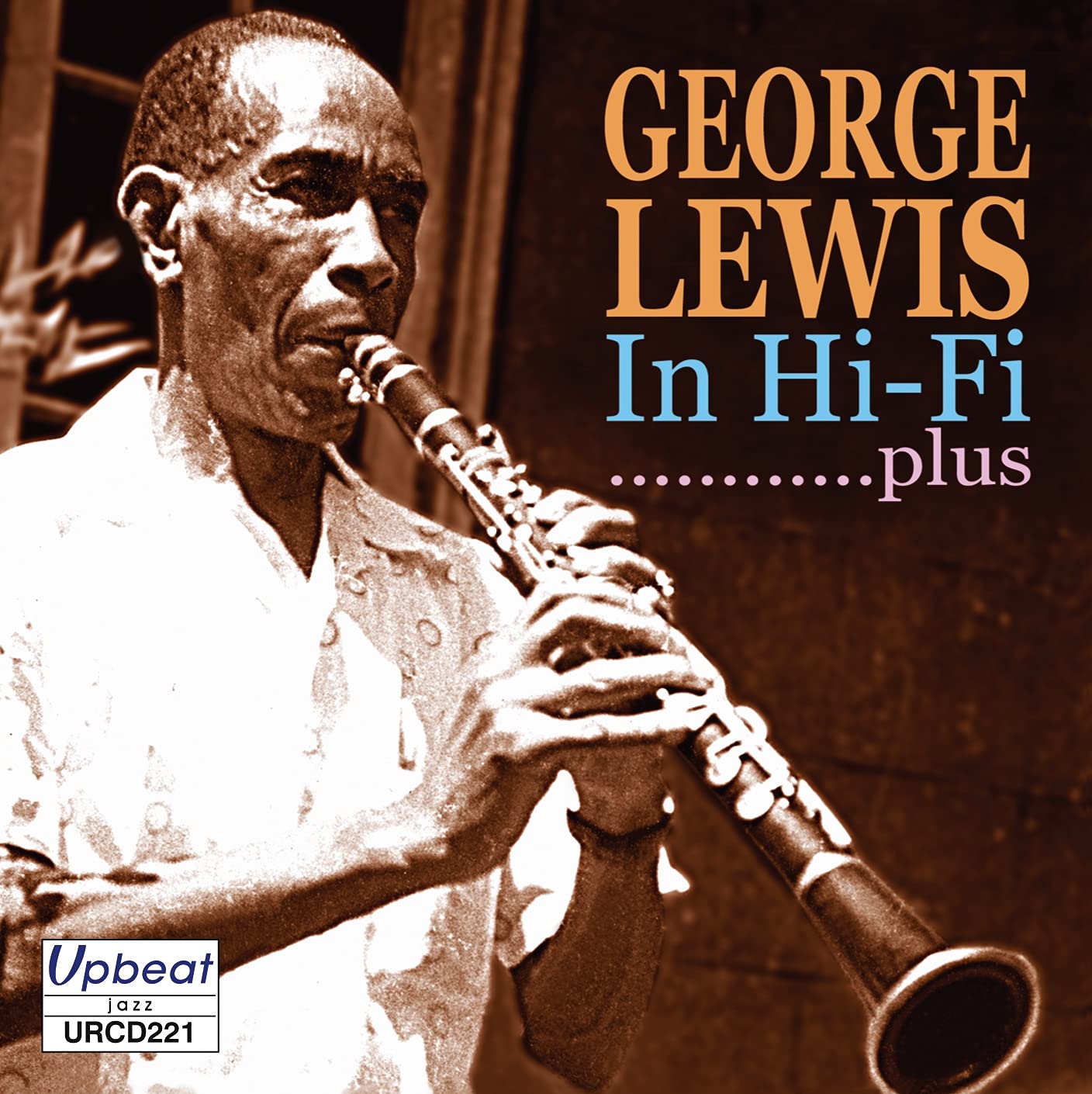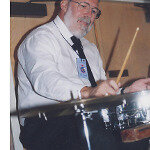 Among those music makers who figured largely in the New Orleans jazz revival, no one stands taller than George Lewis. Until the traditional jazz revival of the late thirties and forties, Lewis, along with several of his fellow New Orleans musicians, never did leave that city for destinations north; there he remained relatively unknown outside of the city until he began recording and touring with the advent of the revival.
Among those music makers who figured largely in the New Orleans jazz revival, no one stands taller than George Lewis. Until the traditional jazz revival of the late thirties and forties, Lewis, along with several of his fellow New Orleans musicians, never did leave that city for destinations north; there he remained relatively unknown outside of the city until he began recording and touring with the advent of the revival.
While Lewis was slender of physique (making it difficult to conceive of him as the stevedore he was at one time, almost losing his life in an accident on the docks in 1943) and soft-spoken in person, through his clarinet he was powerful and intense. This CD gives ample evidence of that, and as in so many of his recordings, Lewis provides virtually a master class on New Orleans style jazz.
Some outstanding instances of his prowess can be heard on “Struttin’ with Some Barbecue” and “That’s a Plenty,” both taken at a very fast clip. Then as if to indicate he could be very facile at slower tempos, there is the wonderful rendition of “Tishomingo Blues,” coming in at 10 minutes and not one of them dull, with a breathtaking duet between Lewis (clarinet) and Thomas (trombone). Such a pairing was very congenial to Lewis—we hear it again in other tracks in the first set, such as “Didn’t He Ramble.” He is equally comfortable in supplying counterpoint to Stanton (cornet), as he does on just about every track in the second set. His arpeggios are models of near-perfection, along with the contrapuntal support he gives the other front-liners.
The instrumentation of the first set lacks the banjo found in most Lewis groups, a long-time favorite banjoist of Lewis being Lawrence Marrero, who could give the band a tremendous lift. The absence of banjo here is fairly well covered, however, by Alton Purnell on piano (many if not most Lewis bands eschewed piano) and two other favorites of Lewis: Slow Drag Pavageau on bass and Joe Watkins on drums. While Big Jim Robinson (not present on this recording) was one of Lewis’ favorite trombonists, Bob Thomas acquits himself well —and Thomas Jefferson is one among many Lewis favored on trumpet or cornet. Unfortunately, he is not as well recorded here as he could have been, so his presence is not pronounced, but what we do hear is quite solid.
The second set, over which there is some debate as to the recording location of all the tracks, has Lewis fronting a trio of cornet, banjo, and bass, with a vocalist added. Most of these musicians were quite familiar to audiences the San Francisco Bay Area, although not as well known outside of that immediate locale. Dick Oxtot introduced Barbara Dane, before that largely a folk singer, to Bob Mielke, leader of his traditional band the Bearcats; and she began to sing the blues as well with jazz bands. (Oxtot was not equally successful in his attempt to introduce Janis Joplin, then unknown, to Turk Murphy to sing some blues. It might have been more fortunate for her had he succeeded.) Stanton was fairly well-known in the San Francisco Bay Area, but we don’t run across Le Sharpton too often in the jazz annals of the area. Of Dane’s two vocals, “Good Morning Blues” is perhaps the lesser known—certainly in my case and Rushing come to mind when I hear that title mentioned.
Lewis, of course, is all over the tracks, dancing and weaving nimbly around the other participants. It is no wonder he was mentor to so many and was a particular favorite in all the countries where he toured. He was especially loved in the UK particularly by Ken Colyer, not the most affable person on the musical scene, and in Japan. They all recognized the talent which he displays here and afforded him the deference it deserved.
Prior to their presence on this Upbeat Recordings CD, the first ten tracks, dating from 1956, appeared previously on LP, first on Cavalier Records in 1956, and then on the Verve and Vogue labels in 1958. The last six tracks were issued on LP and/or EP on Jazz Unlimited, Omega, Polydor, Score, Tempo, and Storyville labels, and on CD on the Storyville label in 1992. It is appropriate that they are available again, thanks to Upbeat recordings, particularly so that young people who are interested in the New Orleans style have access to the work of Lewis. The CD is available from the Upbeat Recordings’ web site www.upbeatmailorder.co.uk and from other web sites such as Amazon.
George Lewis in Hi-Fi . . . . . . . plus
Upbeat URCD 221
www.upbeatmailorder.co.uk
Original Dixieland One-Step; Four or Five Times°; Struttin’ with Some Barbecue; Salty Dog°; That’s a Plenty; Move the Body Over*[Note: Timing should be 6.01, not 0.00]; Don’t Give Up the Ship; Didn’t He Ramble*; She’s Crying for Me; Tishomingo Blues*
Personnel: George Lewis, clarinet; Thomas Jefferson, trumpet; Bob Thomas, trombone; Alton Purnell, piano, vocal°; Alcide “Slow Drag” Pavageau, string bass; Joe Watkins, drums vocal*; Recorded Coast Recording Studios, San Francisco, June 7, 1956
Should I?; Mecca Flat Blues(a); Till We Meet Again(a); The Glory of Love†(b); Good Morning Blues†(b); Smiles(a).
Personnel: George Lewis, clarinet; P. T. Stanton, cornet; Dick Oxtot, banjo; Lelias Sharpton, string bass; Barbara Dane, vocal†; Recorded Jenny Lind Hall, Oakland, 1956 and 1957.
(Note: according to the credits on Storyville CD STCD 6019, “Should I” plus the tracks marked (b) were recorded in the Jenny Lind Hall, Oakland, on June 30, 1956, and those marked (a) were recorded in San Francisco in March, 1957, no other details given. The discography Hymn to George (2001) by Lennard Falt & Hakan Hakansson has the same configuration except that “Should I” is listed with those marked (a).)
Born in Dundee, Scotland, Bert Thompson came to the U.S. in 1956. After a two-year stint playing drums with the 101 st Airborne Division Band and making a number of parachute drops, he returned to civilian life in San Francisco, matriculating at San Francisco State University where he earned a B.A. and an M.A. He went on to matriculate at University of Oregon, where he earned a D.A. and a Ph.D., all of his degrees in English. Now retired, he is a professor emeritus of English at City College of San Francisco. He is also a retired traditional jazz drummer, having played with a number of San Francisco Bay Area bands, including And That’s Jazz, Professor Plum’s Jazz, the Jelly Roll Jazz Band, Mission Gold Jazz Band, and the Zenith New Orleans Parade band; he also played with some further afield, including Gremoli (Long Beach, CA) and the Phoenix Jazzers (Vancouver, B.C.) Today he reviews traditional jazz CDs and writes occasional articles for several publications.























